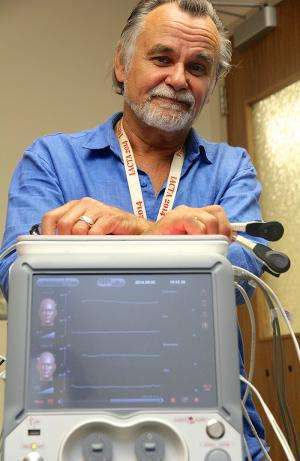Device lets docs stay 'tuned in' to brain bloodflow

For Dr. John Murkin, the medical device business is all about "making a better mouse trap."
The Schulich School of Medicine & Dentistry professor is part of a team of Western and Lawson Health Research Institute (LHRI) researchers studying a new technology that may change the way patients undergoing cardiac surgery are monitored and managed in the hospital.
The device, known as CerOx, non-invasively monitors cerebral blood flow and helps physicians and nurses assess brain perfusion in real time. Murkin, who has been involved in the machine's development, said this information could be used to support critical treatment decisions made to protect the patient from potential complications.
"We use near-infrared light routinely in all hospitals to measure oxygen saturation in the brain. That's been out for 30 years," Murkin said. "This new device is not just measuring oxygen saturation; it's also measuring blood flow to the brain, in real time, and non-invasively.
"If a patient has a brain injury, the more you know about the brain, the better you are at being tuned into their needs."
In cardiac surgery, cerebral monitoring significantly reduces complications, including permanent stroke.
An anesthetist at London Health Sciences Centre and a researcher at LHRI, Murkin has studied cognitive and neurological outcomes in cardiac surgery for more than three decades. He said there has been an unmet clinical need for a noninvasive tool that provides accurate, real-time measurements of cerebral blood flow in these highly vulnerable patients.
Currently, 11 different studies have evaluated CerOx in different applications.
"We've seen the potential of the machine and we're convinced it works," he added. "If you don't know what's going on in the brain, you can't help. But, when you start to monitor this, and you see changes in blood flow, in oxygen saturation and its because of the blood pressure or hemoglobin, or whatever it is, if you pick things up early enough, you can hopefully avoid any possible complications.
"If you can monitor in real time, you can act in real time."
The device is expected to be used primarly by physicians in neuro-critical care areas.
"While the device can alert you to potential problems, the next part is what are you going to do about it? You still need to act," he said. "We want to start looking at what are some of the therapeutic interventions we can use to improve outcomes."

















